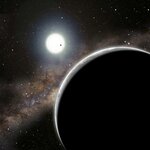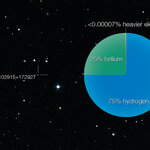Space

Every three hours, NASA's Fermi Gamma-ray Space Telescope scans the entire sky. Every year, the satellite's scientists reanalyze all of the data it has collected about the high energy universe.
A few months ago, the Fermi team released its second catalog of sources detected by the satellite's Large Area Telescope (LAT), producing an inventory of 1,873 objects shining with the highest-energy form of light. "More than half of these sources are active galaxies, whose massive black holes are responsible for the gamma-ray emissions that the LAT detects," said Gino Tosti, an astrophysicist at the…

Kepler-19b, which orbits the Sun-like star Kepler-19 650 light-years from Earth in the constellation Lyra, has been found to have an 'invisible' world tugging on it.
How do astronomers know, since it's invisible? Kepler-19b alternately runs late and early in its orbit, the first definite detection of a previously unknown planet using this method. No other technique could have found the unseen companion.
Kepler-19 is a 12th-magnitude star and can be seen by backyard telescopes on September evenings.
NASA's Kepler spacecraft locates planets by looking for a star that dims slightly…
A fun update, Interorbital lists their filled manifest for their first N30 launch. This is everyone who is building a Tubesat or Cubesat for their first private launch. Put another way, these are all of Calliope's kinfolk. Pioneers, every one of them.
There are 5 Cubesat teams: one domestic uni (UC Irvine), one Danish Google Lunar X Prize team (Team EuroLuna), and 3 international universities: Vietnam, Singapore, and Saudi Arabia universities.
For the Tubesats, we have an awesome mix of edu, corp, and private ventures, that also mix research and fun. The narrative…

Have a telescope? Heck, do you have a pair of binoculars?
If so, head outside the city and take a look at a Type 1A supernova. It's 21 million light-years away, which sounds like a lot, but to astronomers and modern optics that's actually pretty close. So close that over the next few weeks you can even spy it with a pair of good binoculars (25x100), a short while after sunset.
What you will be looking at is a Type 1A supernova in the Pinwheel Galaxy. If you are yet not into astronomy but like the lingo, a Type 1A supernova is carbon-oxygen white dwarf, a little bigger than…

SDSS J102915+172927 is in the constellation of Leo. It has a mass smaller than that of the Sun and is probably more than 13 billion years old and has been found to have the lowest amount of elements heavier than helium (what astronomers call "metals") of all stars yet studied.
The mystery? It shouldn't exist.
"A widely accepted theory predicts that stars like this, with low mass and extremely low quantities of metals, shouldn't exist because the clouds of material from which they formed could never have condensed," said Elisabetta Caffau (Zentrum fur Astronomie der Universitat…

1350 light-years from Earth, near the Orion Nebula, a bright, clumpy jet called called Herbig-Haro 34 (HH 34) ejected from a young star has changed over time - a signpost of star birth.
Stars aren't shy about sending out birth announcements. They fire off energetic jets of glowing gas travellng at supersonic speeds in opposite directions through space. Although astronomers have looked at still pictures of stellar jets for decades, now they can watch movies, thanks to the NASA/ESA Hubble Space Telescope.
A team of scientists has collected enough high-resolution Hubble images…

Do you know what a creepmeter measures? Measurement is the heart of science. What distinguishes science from opinion or philosophy is measureables. The root of science is facts that are determined by actual observation, compared, then extended into predictions.
Any good measurement has three parts: the number value, the units you're using, and the error. If I say I am 6 feet tall, that's a number (6) and a unit (feet), with a presumed error of 'within an inch or two'. All three parts are crucial.
If you want to know how fast your car is going, a number can be a…
FutureTense is a radio program in Australia that I had absolutely never heard of until they decided to interview me. It's time to remedy this for that handful of you out there that, similarly, haven't yet caught them. Thanks to the magic of the web, you don't even have to fly to Australia to enjoy it.
Hosted by Antony Funnell, FutureTense explores 'explores the social, cultural, political and economic faultlines arising from rapid change.' Apparently I'm a potential faultline-- a role I couldn't be happier with-- as Antony interviewed me. They include both podcast and…

2007 OR10, nicknamed Snow White by the graduate student who discovered it because it would presumably be white due to breaking off from icy fellow dwarf planet Haumea, turned out to be red.
Well, it still turned out to be ice also but the surprise is it may have methane slowly dissipating into space, which means it may have once had an atmosphere.
The researchers writing in Astrophysical Journal Letters say OR10 has about half its surface covered in water ice due to ancient, slush-spewing volcanoes. A few other dwarf planets at the edge of the solar system are also red. These distant…

Our solar system, with planets over a range of sizes and moving in near-circular paths, seems to be unusual, according to a model in t Monthly Notices of the Royal Astronomical Society which finds that forming planetary systems may be knocked around by crashes with nearby clumps of material, leading to systems where planets have highly inclined orbits and where the smaller - and potentially habitable - worlds are thrown out completely.
The planets in our Solar System, including the Earth, orbit in the same direction around the Sun as the Sun spins, mostly move in paths not so different from…